BM533 Contemporary Business Economics Report: 2019-20 Assessment
VerifiedAdded on 2023/01/11
|15
|3186
|90
Report
AI Summary
This report delves into the principles of contemporary business economics, focusing on microeconomic concepts. Task 1 critically analyzes the law of demand and supply, including factors that cause shifts in the demand and supply curves, illustrated with diagrams, and applied to a retail business (Sainsbury's). Task 2 compares and contrasts economic theories and models from the 20th and 21st centuries, relating them to modern business practices. The report provides a comprehensive understanding of how economic principles influence business operations and decision-making, incorporating macroeconomic issues like employment, inflation, and economic growth, as well as behavioral economics.
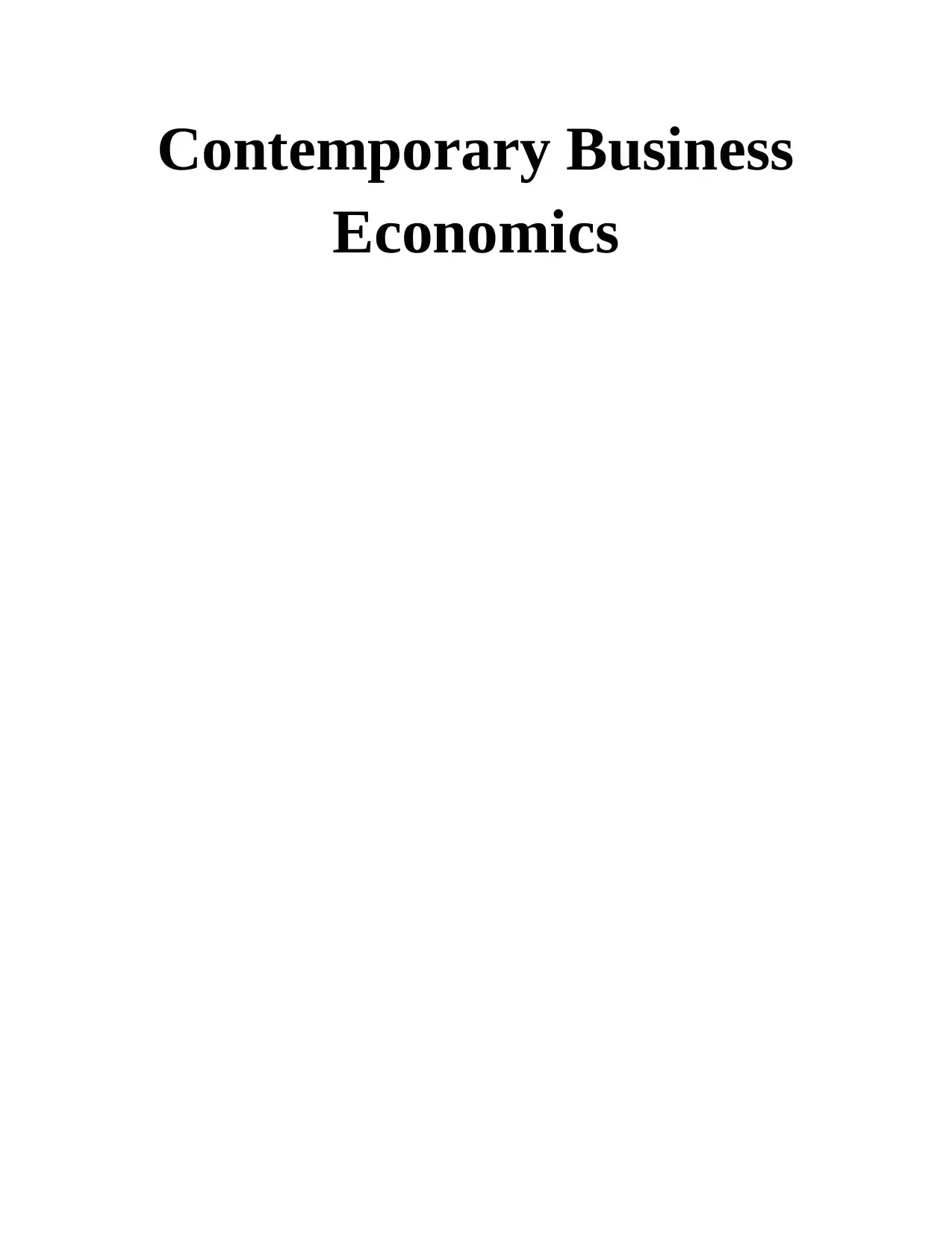
Contemporary Business
Economics
Economics
Paraphrase This Document
Need a fresh take? Get an instant paraphrase of this document with our AI Paraphraser


Contents
INTRODUCTION...........................................................................................................................................3
MAIN BODY.................................................................................................................................................3
TASK 1..........................................................................................................................................................3
1.1 Explain the law of demand along with demand curve and the factors which impact the demand
curve to change.......................................................................................................................................3
1.2 Explain the law of supply by supply curve and also define the factor which change the supply curve
.................................................................................................................................................................6
TASK 2..........................................................................................................................................................9
Comparison and contrasting of theories and models in 21st century with 20th century and application
of them in modern business practices.....................................................................................................9
CONCLUSION.............................................................................................................................................12
REFERENCES..............................................................................................................................................13
INTRODUCTION...........................................................................................................................................3
MAIN BODY.................................................................................................................................................3
TASK 1..........................................................................................................................................................3
1.1 Explain the law of demand along with demand curve and the factors which impact the demand
curve to change.......................................................................................................................................3
1.2 Explain the law of supply by supply curve and also define the factor which change the supply curve
.................................................................................................................................................................6
TASK 2..........................................................................................................................................................9
Comparison and contrasting of theories and models in 21st century with 20th century and application
of them in modern business practices.....................................................................................................9
CONCLUSION.............................................................................................................................................12
REFERENCES..............................................................................................................................................13
⊘ This is a preview!⊘
Do you want full access?
Subscribe today to unlock all pages.

Trusted by 1+ million students worldwide
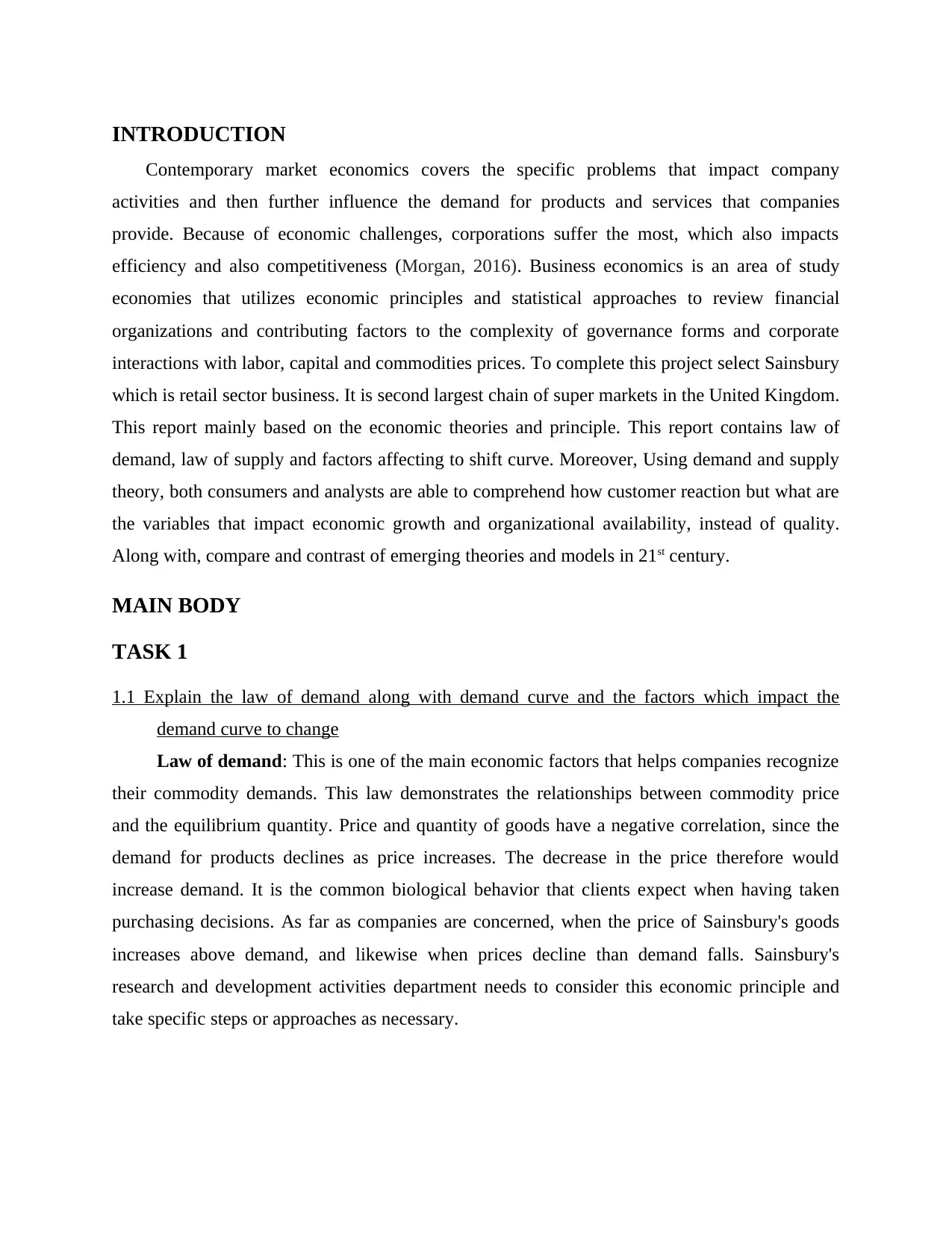
INTRODUCTION
Contemporary market economics covers the specific problems that impact company
activities and then further influence the demand for products and services that companies
provide. Because of economic challenges, corporations suffer the most, which also impacts
efficiency and also competitiveness (Morgan, 2016). Business economics is an area of study
economies that utilizes economic principles and statistical approaches to review financial
organizations and contributing factors to the complexity of governance forms and corporate
interactions with labor, capital and commodities prices. To complete this project select Sainsbury
which is retail sector business. It is second largest chain of super markets in the United Kingdom.
This report mainly based on the economic theories and principle. This report contains law of
demand, law of supply and factors affecting to shift curve. Moreover, Using demand and supply
theory, both consumers and analysts are able to comprehend how customer reaction but what are
the variables that impact economic growth and organizational availability, instead of quality.
Along with, compare and contrast of emerging theories and models in 21st century.
MAIN BODY
TASK 1
1.1 Explain the law of demand along with demand curve and the factors which impact the
demand curve to change
Law of demand: This is one of the main economic factors that helps companies recognize
their commodity demands. This law demonstrates the relationships between commodity price
and the equilibrium quantity. Price and quantity of goods have a negative correlation, since the
demand for products declines as price increases. The decrease in the price therefore would
increase demand. It is the common biological behavior that clients expect when having taken
purchasing decisions. As far as companies are concerned, when the price of Sainsbury's goods
increases above demand, and likewise when prices decline than demand falls. Sainsbury's
research and development activities department needs to consider this economic principle and
take specific steps or approaches as necessary.
Contemporary market economics covers the specific problems that impact company
activities and then further influence the demand for products and services that companies
provide. Because of economic challenges, corporations suffer the most, which also impacts
efficiency and also competitiveness (Morgan, 2016). Business economics is an area of study
economies that utilizes economic principles and statistical approaches to review financial
organizations and contributing factors to the complexity of governance forms and corporate
interactions with labor, capital and commodities prices. To complete this project select Sainsbury
which is retail sector business. It is second largest chain of super markets in the United Kingdom.
This report mainly based on the economic theories and principle. This report contains law of
demand, law of supply and factors affecting to shift curve. Moreover, Using demand and supply
theory, both consumers and analysts are able to comprehend how customer reaction but what are
the variables that impact economic growth and organizational availability, instead of quality.
Along with, compare and contrast of emerging theories and models in 21st century.
MAIN BODY
TASK 1
1.1 Explain the law of demand along with demand curve and the factors which impact the
demand curve to change
Law of demand: This is one of the main economic factors that helps companies recognize
their commodity demands. This law demonstrates the relationships between commodity price
and the equilibrium quantity. Price and quantity of goods have a negative correlation, since the
demand for products declines as price increases. The decrease in the price therefore would
increase demand. It is the common biological behavior that clients expect when having taken
purchasing decisions. As far as companies are concerned, when the price of Sainsbury's goods
increases above demand, and likewise when prices decline than demand falls. Sainsbury's
research and development activities department needs to consider this economic principle and
take specific steps or approaches as necessary.
Paraphrase This Document
Need a fresh take? Get an instant paraphrase of this document with our AI Paraphraser
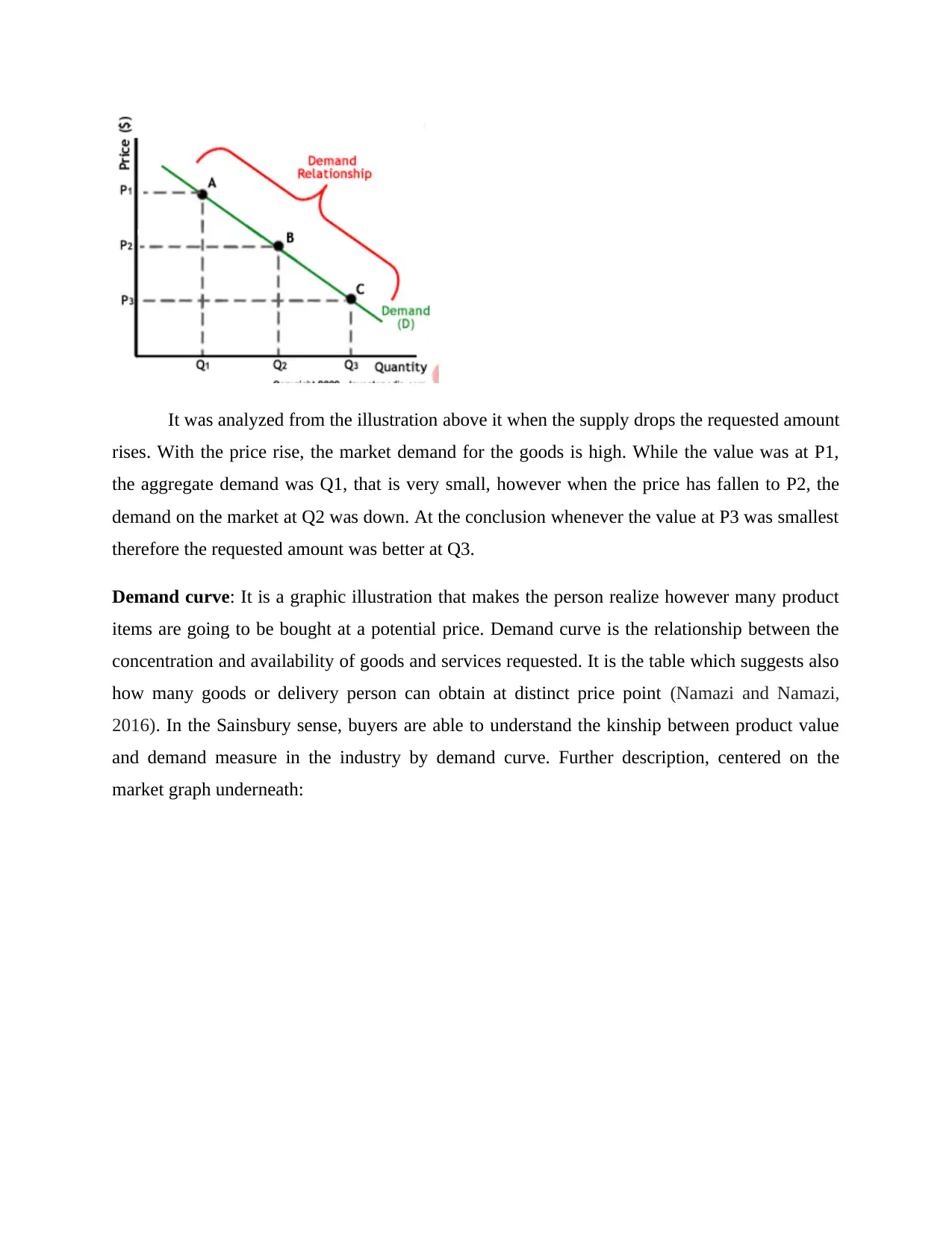
It was analyzed from the illustration above it when the supply drops the requested amount
rises. With the price rise, the market demand for the goods is high. While the value was at P1,
the aggregate demand was Q1, that is very small, however when the price has fallen to P2, the
demand on the market at Q2 was down. At the conclusion whenever the value at P3 was smallest
therefore the requested amount was better at Q3.
Demand curve: It is a graphic illustration that makes the person realize however many product
items are going to be bought at a potential price. Demand curve is the relationship between the
concentration and availability of goods and services requested. It is the table which suggests also
how many goods or delivery person can obtain at distinct price point (Namazi and Namazi,
2016). In the Sainsbury sense, buyers are able to understand the kinship between product value
and demand measure in the industry by demand curve. Further description, centered on the
market graph underneath:
rises. With the price rise, the market demand for the goods is high. While the value was at P1,
the aggregate demand was Q1, that is very small, however when the price has fallen to P2, the
demand on the market at Q2 was down. At the conclusion whenever the value at P3 was smallest
therefore the requested amount was better at Q3.
Demand curve: It is a graphic illustration that makes the person realize however many product
items are going to be bought at a potential price. Demand curve is the relationship between the
concentration and availability of goods and services requested. It is the table which suggests also
how many goods or delivery person can obtain at distinct price point (Namazi and Namazi,
2016). In the Sainsbury sense, buyers are able to understand the kinship between product value
and demand measure in the industry by demand curve. Further description, centered on the
market graph underneath:
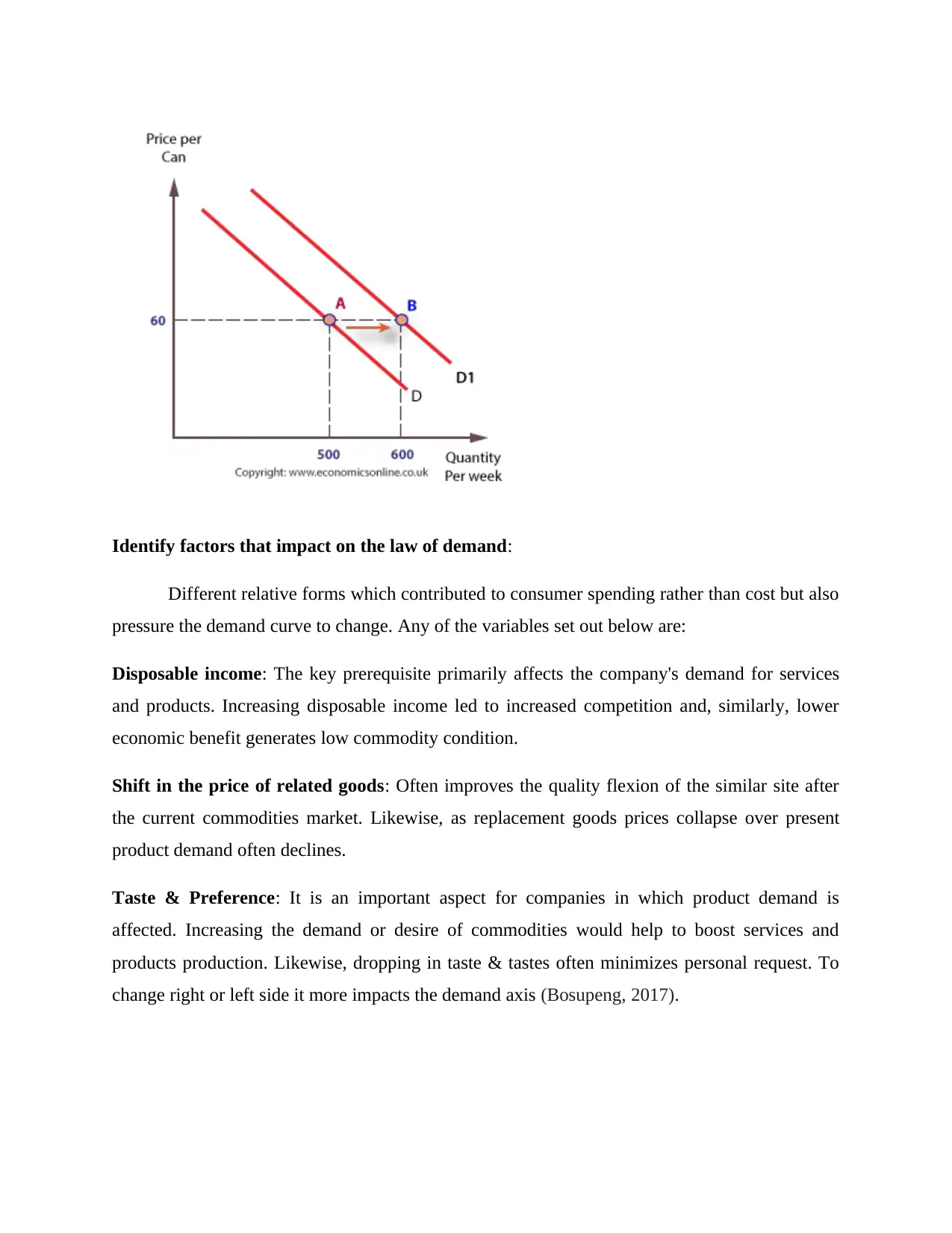
Identify factors that impact on the law of demand:
Different relative forms which contributed to consumer spending rather than cost but also
pressure the demand curve to change. Any of the variables set out below are:
Disposable income: The key prerequisite primarily affects the company's demand for services
and products. Increasing disposable income led to increased competition and, similarly, lower
economic benefit generates low commodity condition.
Shift in the price of related goods: Often improves the quality flexion of the similar site after
the current commodities market. Likewise, as replacement goods prices collapse over present
product demand often declines.
Taste & Preference: It is an important aspect for companies in which product demand is
affected. Increasing the demand or desire of commodities would help to boost services and
products production. Likewise, dropping in taste & tastes often minimizes personal request. To
change right or left side it more impacts the demand axis (Bosupeng, 2017).
Different relative forms which contributed to consumer spending rather than cost but also
pressure the demand curve to change. Any of the variables set out below are:
Disposable income: The key prerequisite primarily affects the company's demand for services
and products. Increasing disposable income led to increased competition and, similarly, lower
economic benefit generates low commodity condition.
Shift in the price of related goods: Often improves the quality flexion of the similar site after
the current commodities market. Likewise, as replacement goods prices collapse over present
product demand often declines.
Taste & Preference: It is an important aspect for companies in which product demand is
affected. Increasing the demand or desire of commodities would help to boost services and
products production. Likewise, dropping in taste & tastes often minimizes personal request. To
change right or left side it more impacts the demand axis (Bosupeng, 2017).
⊘ This is a preview!⊘
Do you want full access?
Subscribe today to unlock all pages.

Trusted by 1+ million students worldwide
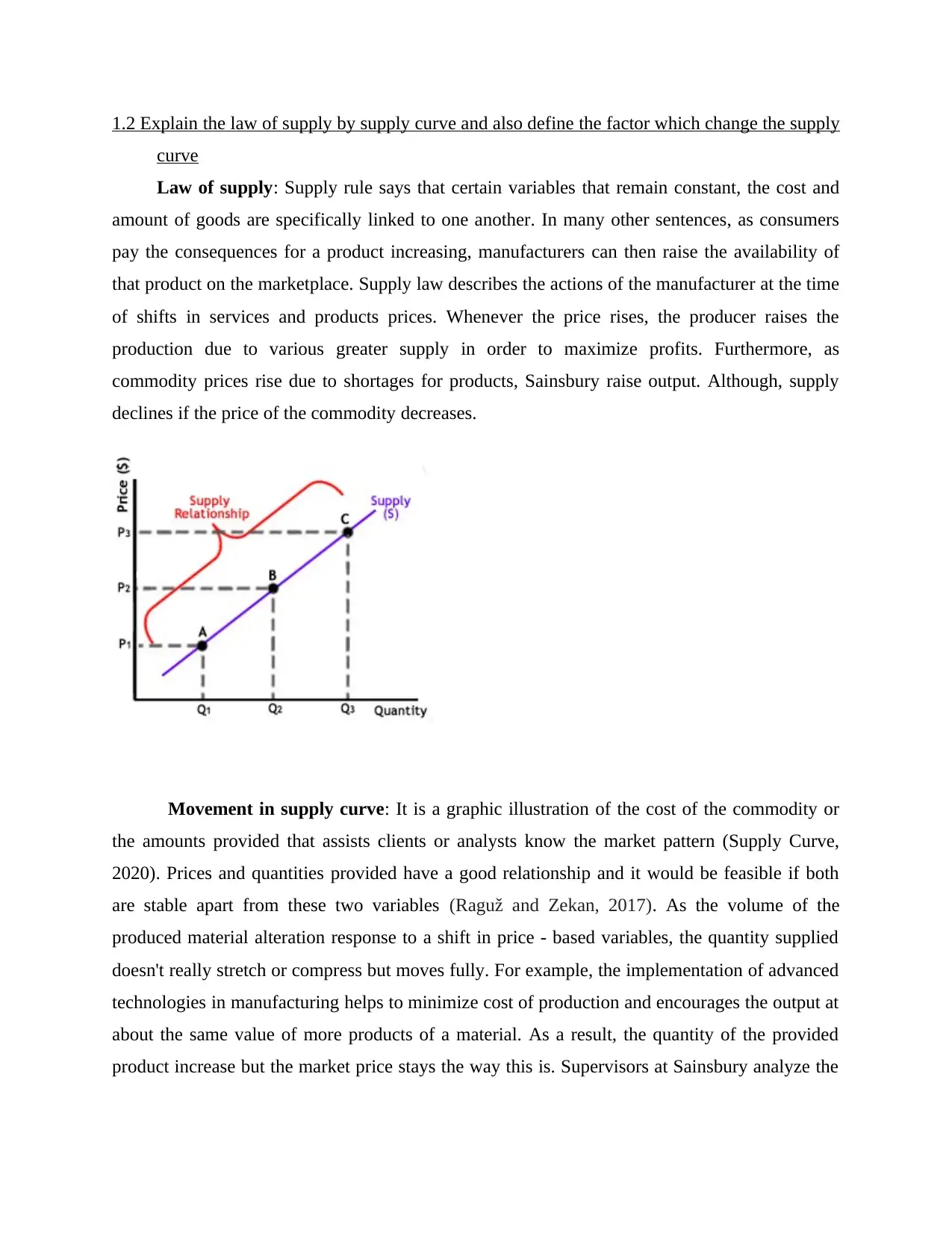
1.2 Explain the law of supply by supply curve and also define the factor which change the supply
curve
Law of supply: Supply rule says that certain variables that remain constant, the cost and
amount of goods are specifically linked to one another. In many other sentences, as consumers
pay the consequences for a product increasing, manufacturers can then raise the availability of
that product on the marketplace. Supply law describes the actions of the manufacturer at the time
of shifts in services and products prices. Whenever the price rises, the producer raises the
production due to various greater supply in order to maximize profits. Furthermore, as
commodity prices rise due to shortages for products, Sainsbury raise output. Although, supply
declines if the price of the commodity decreases.
Movement in supply curve: It is a graphic illustration of the cost of the commodity or
the amounts provided that assists clients or analysts know the market pattern (Supply Curve,
2020). Prices and quantities provided have a good relationship and it would be feasible if both
are stable apart from these two variables (Raguž and Zekan, 2017). As the volume of the
produced material alteration response to a shift in price - based variables, the quantity supplied
doesn't really stretch or compress but moves fully. For example, the implementation of advanced
technologies in manufacturing helps to minimize cost of production and encourages the output at
about the same value of more products of a material. As a result, the quantity of the provided
product increase but the market price stays the way this is. Supervisors at Sainsbury analyze the
curve
Law of supply: Supply rule says that certain variables that remain constant, the cost and
amount of goods are specifically linked to one another. In many other sentences, as consumers
pay the consequences for a product increasing, manufacturers can then raise the availability of
that product on the marketplace. Supply law describes the actions of the manufacturer at the time
of shifts in services and products prices. Whenever the price rises, the producer raises the
production due to various greater supply in order to maximize profits. Furthermore, as
commodity prices rise due to shortages for products, Sainsbury raise output. Although, supply
declines if the price of the commodity decreases.
Movement in supply curve: It is a graphic illustration of the cost of the commodity or
the amounts provided that assists clients or analysts know the market pattern (Supply Curve,
2020). Prices and quantities provided have a good relationship and it would be feasible if both
are stable apart from these two variables (Raguž and Zekan, 2017). As the volume of the
produced material alteration response to a shift in price - based variables, the quantity supplied
doesn't really stretch or compress but moves fully. For example, the implementation of advanced
technologies in manufacturing helps to minimize cost of production and encourages the output at
about the same value of more products of a material. As a result, the quantity of the provided
product increase but the market price stays the way this is. Supervisors at Sainsbury analyze the
Paraphrase This Document
Need a fresh take? Get an instant paraphrase of this document with our AI Paraphraser
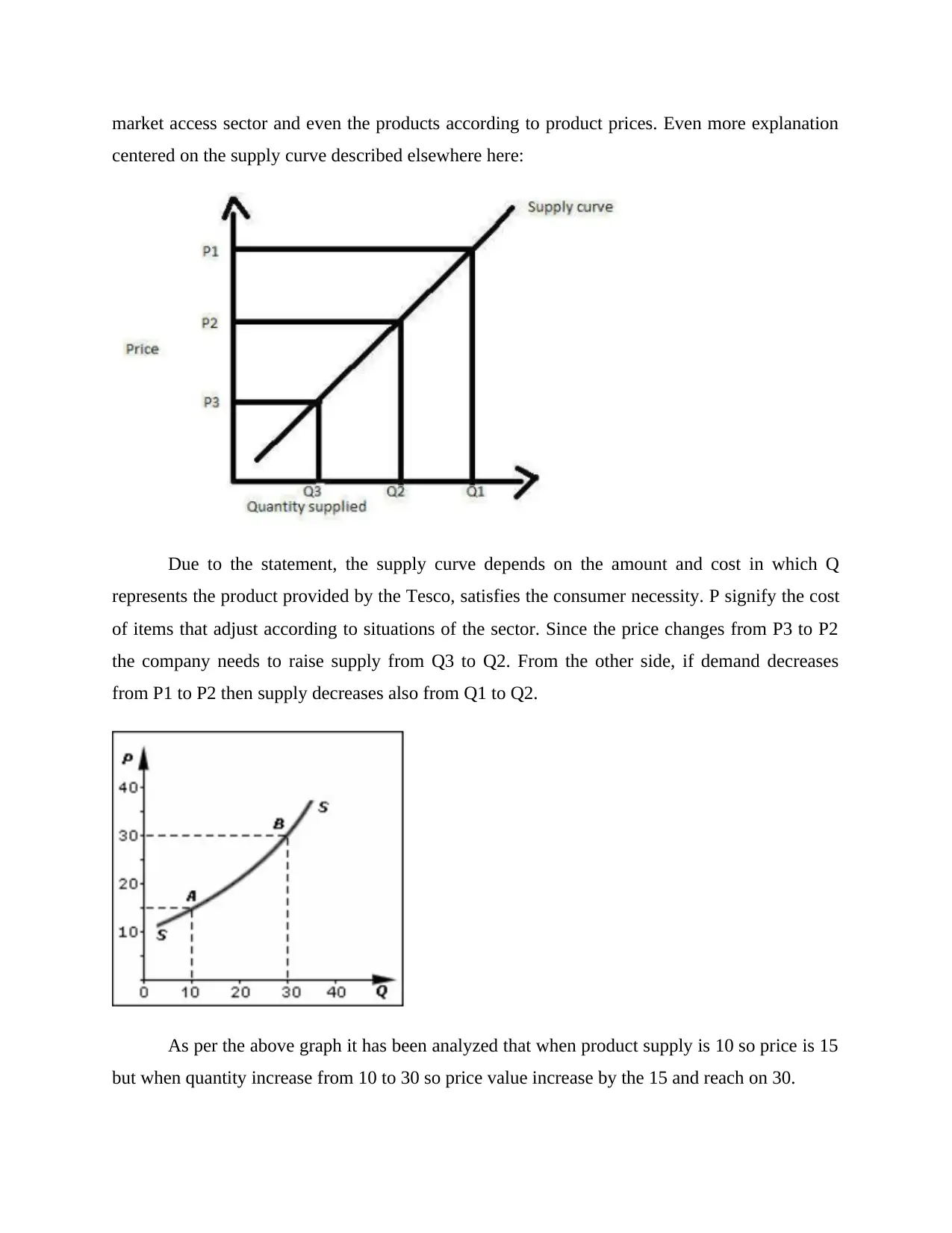
market access sector and even the products according to product prices. Even more explanation
centered on the supply curve described elsewhere here:
Due to the statement, the supply curve depends on the amount and cost in which Q
represents the product provided by the Tesco, satisfies the consumer necessity. P signify the cost
of items that adjust according to situations of the sector. Since the price changes from P3 to P2
the company needs to raise supply from Q3 to Q2. From the other side, if demand decreases
from P1 to P2 then supply decreases also from Q1 to Q2.
As per the above graph it has been analyzed that when product supply is 10 so price is 15
but when quantity increase from 10 to 30 so price value increase by the 15 and reach on 30.
centered on the supply curve described elsewhere here:
Due to the statement, the supply curve depends on the amount and cost in which Q
represents the product provided by the Tesco, satisfies the consumer necessity. P signify the cost
of items that adjust according to situations of the sector. Since the price changes from P3 to P2
the company needs to raise supply from Q3 to Q2. From the other side, if demand decreases
from P1 to P2 then supply decreases also from Q1 to Q2.
As per the above graph it has been analyzed that when product supply is 10 so price is 15
but when quantity increase from 10 to 30 so price value increase by the 15 and reach on 30.
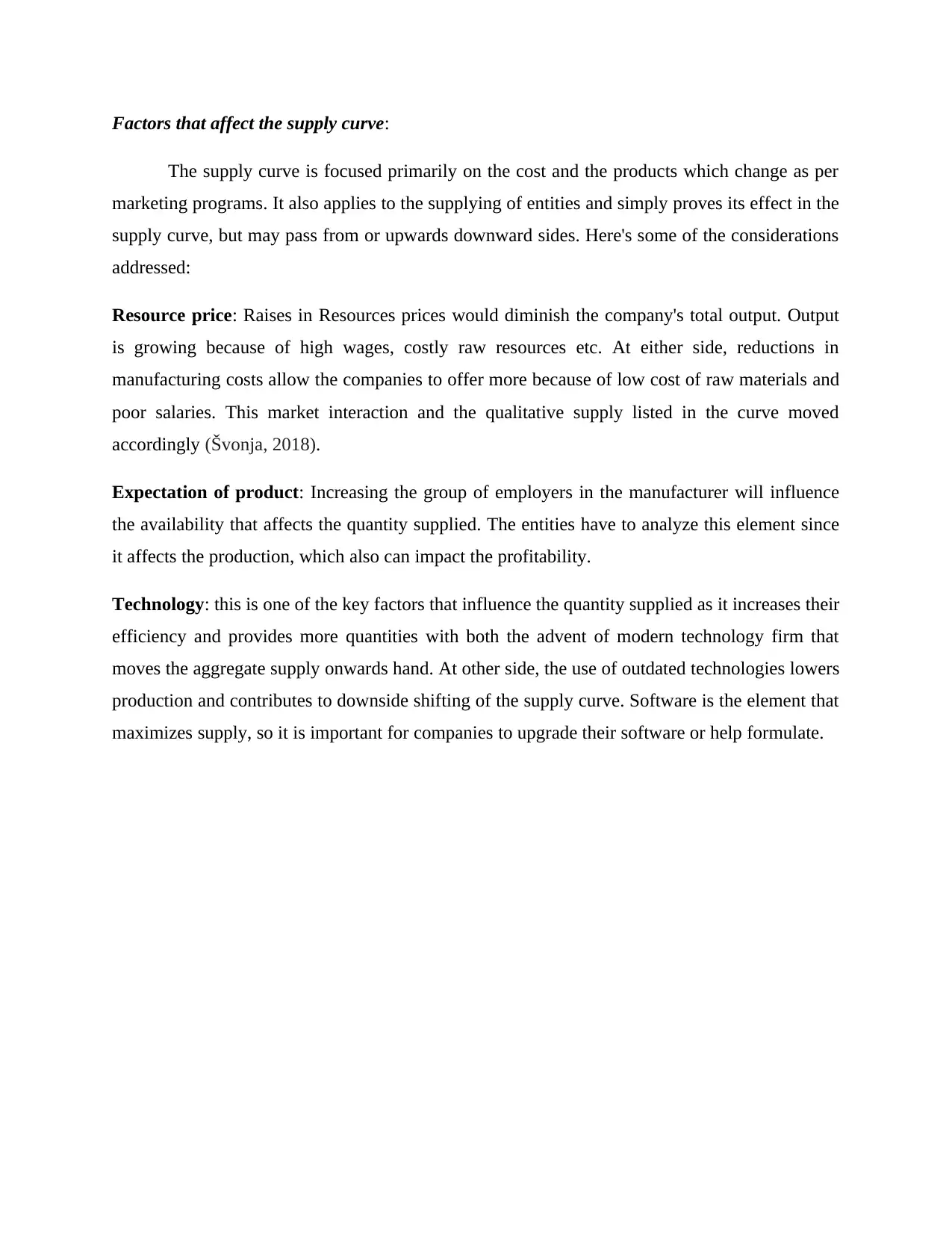
Factors that affect the supply curve:
The supply curve is focused primarily on the cost and the products which change as per
marketing programs. It also applies to the supplying of entities and simply proves its effect in the
supply curve, but may pass from or upwards downward sides. Here's some of the considerations
addressed:
Resource price: Raises in Resources prices would diminish the company's total output. Output
is growing because of high wages, costly raw resources etc. At either side, reductions in
manufacturing costs allow the companies to offer more because of low cost of raw materials and
poor salaries. This market interaction and the qualitative supply listed in the curve moved
accordingly (Švonja, 2018).
Expectation of product: Increasing the group of employers in the manufacturer will influence
the availability that affects the quantity supplied. The entities have to analyze this element since
it affects the production, which also can impact the profitability.
Technology: this is one of the key factors that influence the quantity supplied as it increases their
efficiency and provides more quantities with both the advent of modern technology firm that
moves the aggregate supply onwards hand. At other side, the use of outdated technologies lowers
production and contributes to downside shifting of the supply curve. Software is the element that
maximizes supply, so it is important for companies to upgrade their software or help formulate.
The supply curve is focused primarily on the cost and the products which change as per
marketing programs. It also applies to the supplying of entities and simply proves its effect in the
supply curve, but may pass from or upwards downward sides. Here's some of the considerations
addressed:
Resource price: Raises in Resources prices would diminish the company's total output. Output
is growing because of high wages, costly raw resources etc. At either side, reductions in
manufacturing costs allow the companies to offer more because of low cost of raw materials and
poor salaries. This market interaction and the qualitative supply listed in the curve moved
accordingly (Švonja, 2018).
Expectation of product: Increasing the group of employers in the manufacturer will influence
the availability that affects the quantity supplied. The entities have to analyze this element since
it affects the production, which also can impact the profitability.
Technology: this is one of the key factors that influence the quantity supplied as it increases their
efficiency and provides more quantities with both the advent of modern technology firm that
moves the aggregate supply onwards hand. At other side, the use of outdated technologies lowers
production and contributes to downside shifting of the supply curve. Software is the element that
maximizes supply, so it is important for companies to upgrade their software or help formulate.
⊘ This is a preview!⊘
Do you want full access?
Subscribe today to unlock all pages.

Trusted by 1+ million students worldwide
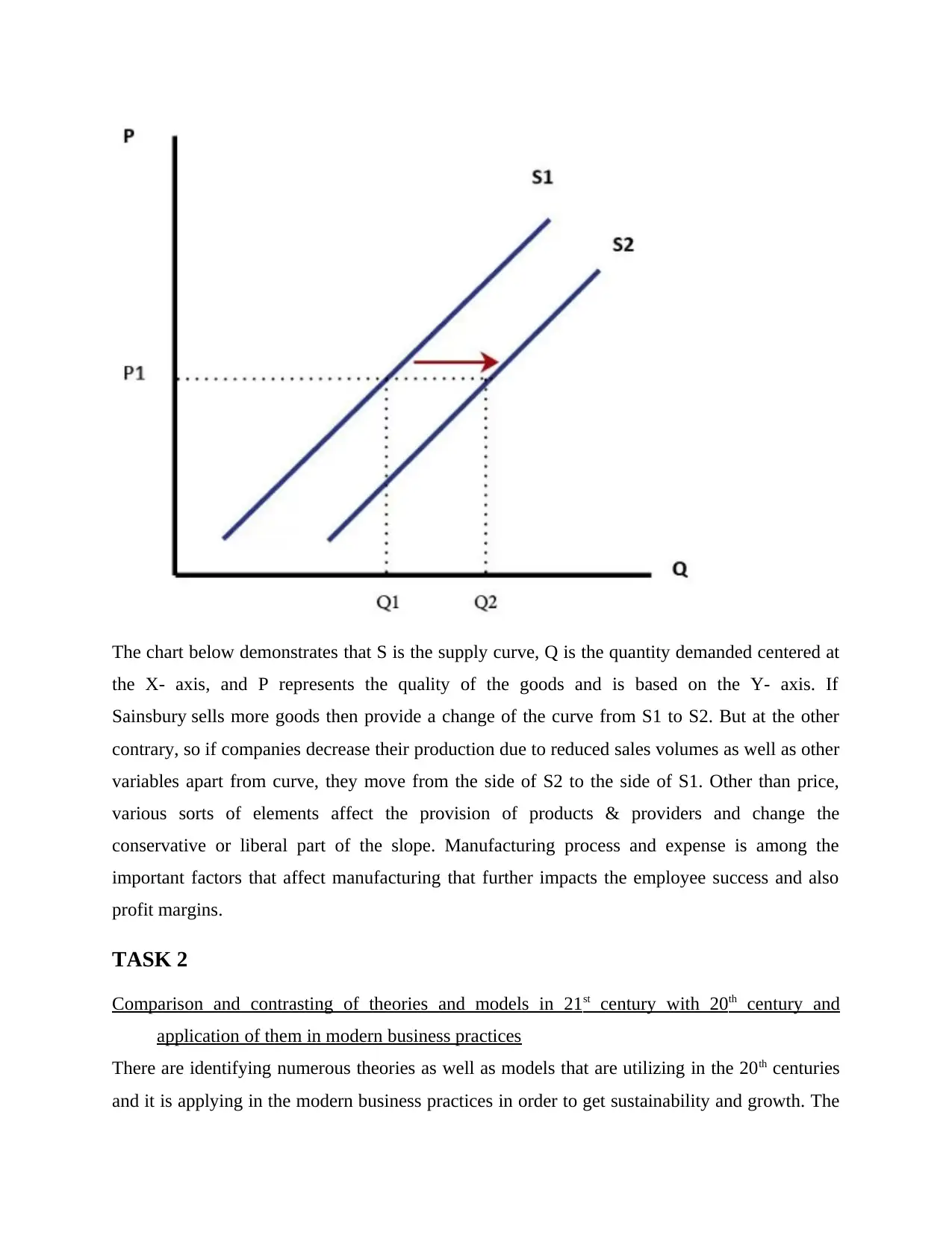
The chart below demonstrates that S is the supply curve, Q is the quantity demanded centered at
the X- axis, and P represents the quality of the goods and is based on the Y- axis. If
Sainsbury sells more goods then provide a change of the curve from S1 to S2. But at the other
contrary, so if companies decrease their production due to reduced sales volumes as well as other
variables apart from curve, they move from the side of S2 to the side of S1. Other than price,
various sorts of elements affect the provision of products & providers and change the
conservative or liberal part of the slope. Manufacturing process and expense is among the
important factors that affect manufacturing that further impacts the employee success and also
profit margins.
TASK 2
Comparison and contrasting of theories and models in 21st century with 20th century and
application of them in modern business practices
There are identifying numerous theories as well as models that are utilizing in the 20th centuries
and it is applying in the modern business practices in order to get sustainability and growth. The
the X- axis, and P represents the quality of the goods and is based on the Y- axis. If
Sainsbury sells more goods then provide a change of the curve from S1 to S2. But at the other
contrary, so if companies decrease their production due to reduced sales volumes as well as other
variables apart from curve, they move from the side of S2 to the side of S1. Other than price,
various sorts of elements affect the provision of products & providers and change the
conservative or liberal part of the slope. Manufacturing process and expense is among the
important factors that affect manufacturing that further impacts the employee success and also
profit margins.
TASK 2
Comparison and contrasting of theories and models in 21st century with 20th century and
application of them in modern business practices
There are identifying numerous theories as well as models that are utilizing in the 20th centuries
and it is applying in the modern business practices in order to get sustainability and growth. The
Paraphrase This Document
Need a fresh take? Get an instant paraphrase of this document with our AI Paraphraser
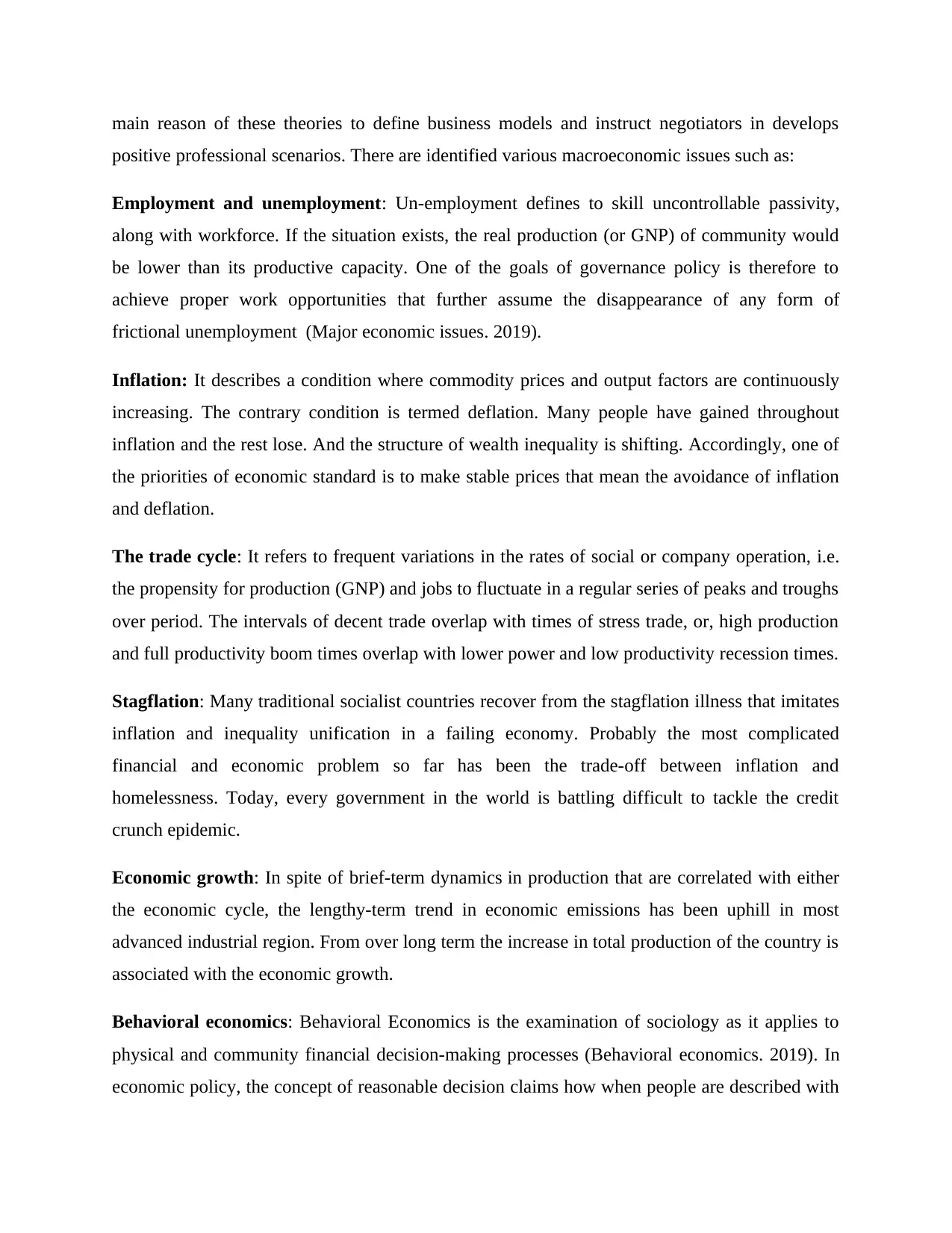
main reason of these theories to define business models and instruct negotiators in develops
positive professional scenarios. There are identified various macroeconomic issues such as:
Employment and unemployment: Un-employment defines to skill uncontrollable passivity,
along with workforce. If the situation exists, the real production (or GNP) of community would
be lower than its productive capacity. One of the goals of governance policy is therefore to
achieve proper work opportunities that further assume the disappearance of any form of
frictional unemployment (Major economic issues. 2019).
Inflation: It describes a condition where commodity prices and output factors are continuously
increasing. The contrary condition is termed deflation. Many people have gained throughout
inflation and the rest lose. And the structure of wealth inequality is shifting. Accordingly, one of
the priorities of economic standard is to make stable prices that mean the avoidance of inflation
and deflation.
The trade cycle: It refers to frequent variations in the rates of social or company operation, i.e.
the propensity for production (GNP) and jobs to fluctuate in a regular series of peaks and troughs
over period. The intervals of decent trade overlap with times of stress trade, or, high production
and full productivity boom times overlap with lower power and low productivity recession times.
Stagflation: Many traditional socialist countries recover from the stagflation illness that imitates
inflation and inequality unification in a failing economy. Probably the most complicated
financial and economic problem so far has been the trade-off between inflation and
homelessness. Today, every government in the world is battling difficult to tackle the credit
crunch epidemic.
Economic growth: In spite of brief-term dynamics in production that are correlated with either
the economic cycle, the lengthy-term trend in economic emissions has been uphill in most
advanced industrial region. From over long term the increase in total production of the country is
associated with the economic growth.
Behavioral economics: Behavioral Economics is the examination of sociology as it applies to
physical and community financial decision-making processes (Behavioral economics. 2019). In
economic policy, the concept of reasonable decision claims how when people are described with
positive professional scenarios. There are identified various macroeconomic issues such as:
Employment and unemployment: Un-employment defines to skill uncontrollable passivity,
along with workforce. If the situation exists, the real production (or GNP) of community would
be lower than its productive capacity. One of the goals of governance policy is therefore to
achieve proper work opportunities that further assume the disappearance of any form of
frictional unemployment (Major economic issues. 2019).
Inflation: It describes a condition where commodity prices and output factors are continuously
increasing. The contrary condition is termed deflation. Many people have gained throughout
inflation and the rest lose. And the structure of wealth inequality is shifting. Accordingly, one of
the priorities of economic standard is to make stable prices that mean the avoidance of inflation
and deflation.
The trade cycle: It refers to frequent variations in the rates of social or company operation, i.e.
the propensity for production (GNP) and jobs to fluctuate in a regular series of peaks and troughs
over period. The intervals of decent trade overlap with times of stress trade, or, high production
and full productivity boom times overlap with lower power and low productivity recession times.
Stagflation: Many traditional socialist countries recover from the stagflation illness that imitates
inflation and inequality unification in a failing economy. Probably the most complicated
financial and economic problem so far has been the trade-off between inflation and
homelessness. Today, every government in the world is battling difficult to tackle the credit
crunch epidemic.
Economic growth: In spite of brief-term dynamics in production that are correlated with either
the economic cycle, the lengthy-term trend in economic emissions has been uphill in most
advanced industrial region. From over long term the increase in total production of the country is
associated with the economic growth.
Behavioral economics: Behavioral Economics is the examination of sociology as it applies to
physical and community financial decision-making processes (Behavioral economics. 2019). In
economic policy, the concept of reasonable decision claims how when people are described with
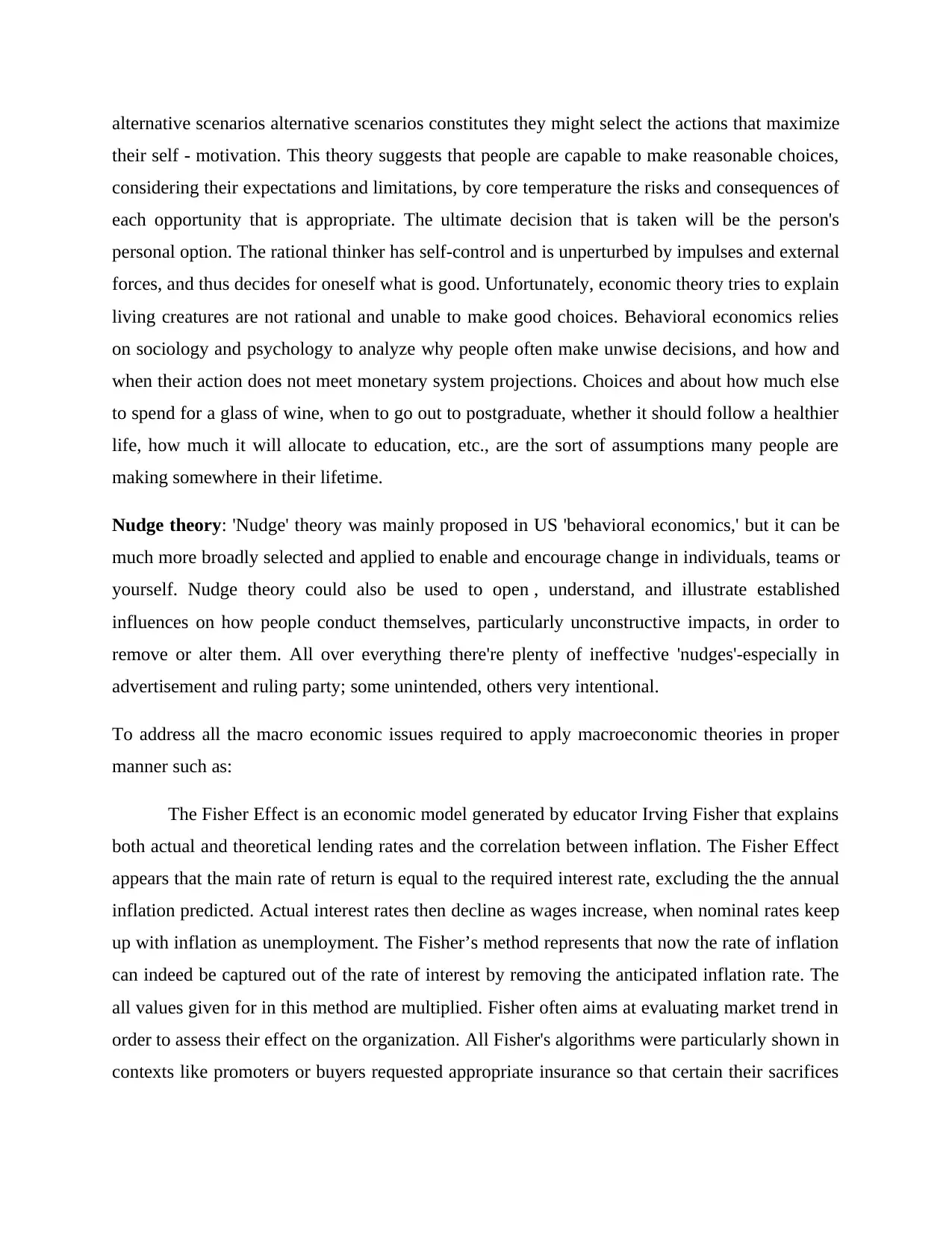
alternative scenarios alternative scenarios constitutes they might select the actions that maximize
their self - motivation. This theory suggests that people are capable to make reasonable choices,
considering their expectations and limitations, by core temperature the risks and consequences of
each opportunity that is appropriate. The ultimate decision that is taken will be the person's
personal option. The rational thinker has self-control and is unperturbed by impulses and external
forces, and thus decides for oneself what is good. Unfortunately, economic theory tries to explain
living creatures are not rational and unable to make good choices. Behavioral economics relies
on sociology and psychology to analyze why people often make unwise decisions, and how and
when their action does not meet monetary system projections. Choices and about how much else
to spend for a glass of wine, when to go out to postgraduate, whether it should follow a healthier
life, how much it will allocate to education, etc., are the sort of assumptions many people are
making somewhere in their lifetime.
Nudge theory: 'Nudge' theory was mainly proposed in US 'behavioral economics,' but it can be
much more broadly selected and applied to enable and encourage change in individuals, teams or
yourself. Nudge theory could also be used to open , understand, and illustrate established
influences on how people conduct themselves, particularly unconstructive impacts, in order to
remove or alter them. All over everything there're plenty of ineffective 'nudges'-especially in
advertisement and ruling party; some unintended, others very intentional.
To address all the macro economic issues required to apply macroeconomic theories in proper
manner such as:
The Fisher Effect is an economic model generated by educator Irving Fisher that explains
both actual and theoretical lending rates and the correlation between inflation. The Fisher Effect
appears that the main rate of return is equal to the required interest rate, excluding the the annual
inflation predicted. Actual interest rates then decline as wages increase, when nominal rates keep
up with inflation as unemployment. The Fisher’s method represents that now the rate of inflation
can indeed be captured out of the rate of interest by removing the anticipated inflation rate. The
all values given for in this method are multiplied. Fisher often aims at evaluating market trend in
order to assess their effect on the organization. All Fisher's algorithms were particularly shown in
contexts like promoters or buyers requested appropriate insurance so that certain their sacrifices
their self - motivation. This theory suggests that people are capable to make reasonable choices,
considering their expectations and limitations, by core temperature the risks and consequences of
each opportunity that is appropriate. The ultimate decision that is taken will be the person's
personal option. The rational thinker has self-control and is unperturbed by impulses and external
forces, and thus decides for oneself what is good. Unfortunately, economic theory tries to explain
living creatures are not rational and unable to make good choices. Behavioral economics relies
on sociology and psychology to analyze why people often make unwise decisions, and how and
when their action does not meet monetary system projections. Choices and about how much else
to spend for a glass of wine, when to go out to postgraduate, whether it should follow a healthier
life, how much it will allocate to education, etc., are the sort of assumptions many people are
making somewhere in their lifetime.
Nudge theory: 'Nudge' theory was mainly proposed in US 'behavioral economics,' but it can be
much more broadly selected and applied to enable and encourage change in individuals, teams or
yourself. Nudge theory could also be used to open , understand, and illustrate established
influences on how people conduct themselves, particularly unconstructive impacts, in order to
remove or alter them. All over everything there're plenty of ineffective 'nudges'-especially in
advertisement and ruling party; some unintended, others very intentional.
To address all the macro economic issues required to apply macroeconomic theories in proper
manner such as:
The Fisher Effect is an economic model generated by educator Irving Fisher that explains
both actual and theoretical lending rates and the correlation between inflation. The Fisher Effect
appears that the main rate of return is equal to the required interest rate, excluding the the annual
inflation predicted. Actual interest rates then decline as wages increase, when nominal rates keep
up with inflation as unemployment. The Fisher’s method represents that now the rate of inflation
can indeed be captured out of the rate of interest by removing the anticipated inflation rate. The
all values given for in this method are multiplied. Fisher often aims at evaluating market trend in
order to assess their effect on the organization. All Fisher's algorithms were particularly shown in
contexts like promoters or buyers requested appropriate insurance so that certain their sacrifices
⊘ This is a preview!⊘
Do you want full access?
Subscribe today to unlock all pages.

Trusted by 1+ million students worldwide
1 out of 15
Related Documents
Your All-in-One AI-Powered Toolkit for Academic Success.
+13062052269
info@desklib.com
Available 24*7 on WhatsApp / Email
![[object Object]](/_next/static/media/star-bottom.7253800d.svg)
Unlock your academic potential
Copyright © 2020–2025 A2Z Services. All Rights Reserved. Developed and managed by ZUCOL.



